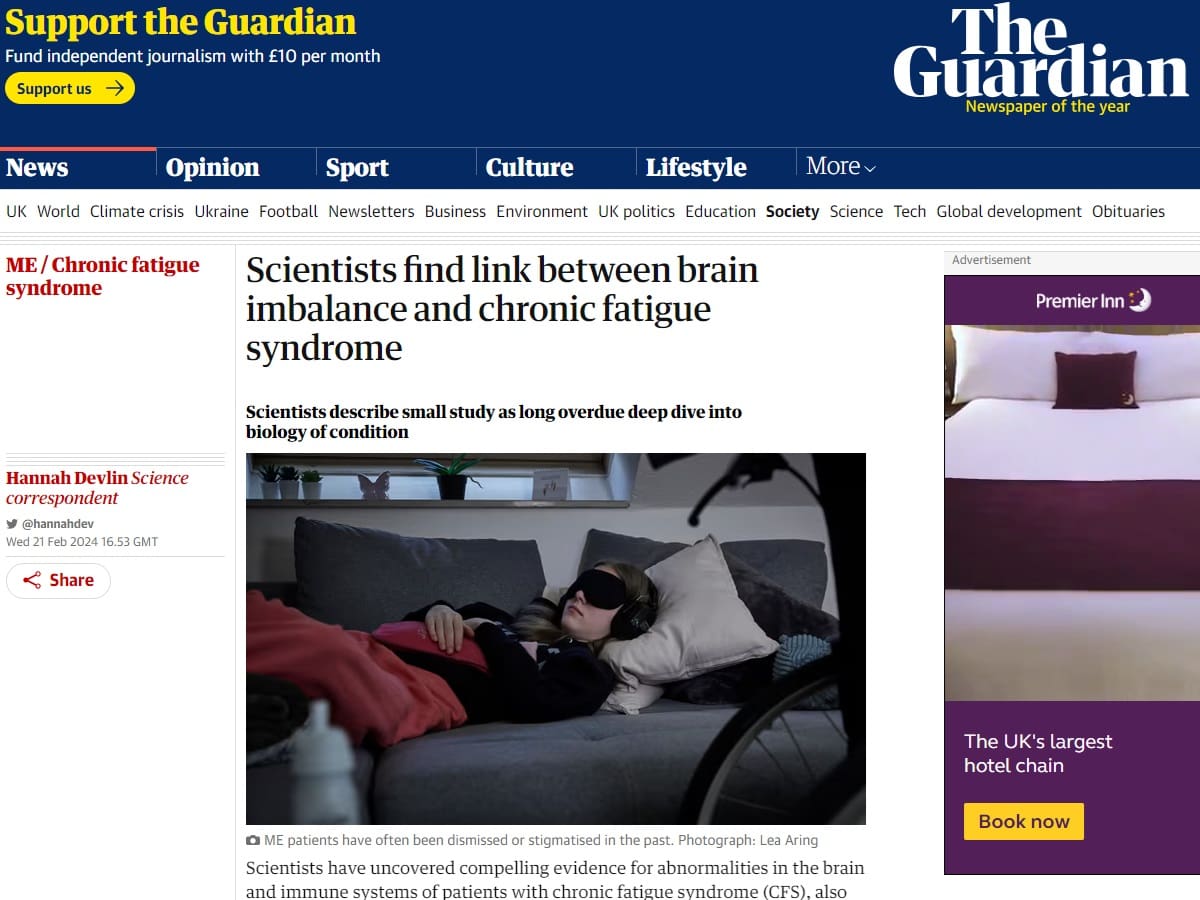Two studies – ME, long Covid ones – have been projected into the spotlight thanks to the corporate media. Both studies claim to be groundbreaking in terms of research. However, the reality is both are little more than junk science promoted by people with hidden agendas, and lapped up by churnalists.
Meanwhile, it’s left to chronically ill and disabled patients to call the studies out for what they are – at worst, potential scientific fraud. Sadly, this is nothing new. However, the implications of this trash research could still be far-reaching.
A new ME study from the US
A new intramural study into myalgic encephalomyelitis (ME) was recently published in the US, and the results published in Nature. As it reported:
In 2016, the National Institutes of Health (NIH) launched an initiative to study ME/CFS. The NIH Division of Intramural Research developed an exploratory clinical research program to perform deep phenotyping on a cohort of PI-ME/CFS participants and healthy volunteers (HV) as controls.
Prior to the SARS-CoV-2 pandemic, this study recruited a cohort of well-characterized PI-ME/CFS patients and applied modern broad and deep scientific measures to describe their biophenotype compared to HVs. The aim was to identify relevant group differences that could generate new hypotheses about the pathogenesis of PI-ME/CFS and provide direction for future research.
Over 75 scientists and clinicians across 15 of the 27 institutes that comprise the NIH contributed to this multi-disciplinary work.
Wow. That sounds impressive, right? “Deep scientific measures”; ‘generating new hypotheses’; “over 75 scientists”, and ‘future research’. Exciting stuff – except it really wasn’t, especially when you put a price tag of around $8m on it.
NIH: tell us something we don’t know
A lot of the NIH ME study’s results were already known. For example, Nature stated that:
Increased heart rate in PI-ME/CFS participants throughout the course of a day suggests comparatively increased sympathetic activity… Considered together, these data suggest that there is an alteration in autonomic tone, implying central nervous system regulatory change.
Yes, that’s generally called postural orthostatic tachycardia syndrome (POTS) and dysautonomia – which we already know both exist with ME.
Moreover, the study failed to link the sympathetic overactivity with fatigue – instead boxing the latter off as in some cases being down to:
Effort preference, the decision to avoid the harder task when decision-making is unsupervised and reward values and probabilities of receiving a reward are standardized…
And:
dysfunction of integrative brain regions that drive the motor cortex
That is, the brain is telling the body something is going to be more tiring than it actually will be therefore don’t do it – ergo, when you do it it feels more tiring; if you can believe that. This was the central takeaway from the NIH ME study: that neurological dysfunction is causing people’s fatigue.
Of course, previous studies into diseases like dementia have already hinted at the role the brain plays in exercise – or, vice-versa. Therefore, in the NIH ME study correlation still doesn’t mean causation.
David Tuller is a senior fellow in public health and journalism at the University of California, Berkeley, and expert on ME. He told the Canary that:
Besides having a tiny sample, the study has obvious significant and even disastrous flaws – a spectacularly misguided focus on something called “effort preference” rather than post-exertional malaise (PEM) and the decision to put patients through a one-day but not two-day cardio pulmonary exercise test (CPET) regimen, for example.
At the same time, the study placed immune system disruptions and related factors at the root of the cluster of illnesses we’re calling ME/CFS and dismissed the notion that psychiatric and psychological conditions are causal factors. Hopefully the “effort preference” debacle and other legitimate concerns will not obscure that important message.
Building on Tuller’s pertinent points, the issue of the two-day CPET test is crucial.
Where’s the second CPET?
In previous studies, ME patients have shown reduced physiological results and tolerance to exertion on the second day of a CPET test versus the first. The point being – ME patients’ brains aren’t disrupting how fatigued they get (therefore, they involuntarily ‘choose’ less-tiring tasks). Their bodies literally cannot sustain repeated exertion – that is, PEM.
Moreover, the authors assert that the ME group have deconditioning when the control group doesn’t, due to the CPET results. If they had bothered to perform a second day CPET test, this would have shown the ME group did not have deconditioning – they had PEM.
Therefore, the NIH study’s failure to do a two-day CPET undermines its findings surrounding the brain’s role in fatigue and the whole idea of “effort preference”.
Overall, the NIH study was, as a sum of its parts, pointless. As Tuller noted, there were important points surrounding some biomechanical/immune aspects of the disease. However, these findings are not particularly revelatory, nor many of them new – and the catastrophic failings in other areas leave the NIH study a waste of money and pointless exercise.
Karen Leslie, co-founder of Physios for ME, told the Canary:
With the wide variance in severity and type of symptoms experienced by people with ME, no clinically significant conclusions can be drawn from a population of 17. It therefore feels like a missed opportunity given the funding and resources available for this particular study.
However, if the NIH study wasn’t good, then a recent piece of so-called research into long Covid was disastrous – for both patient populations.
REGAIN study into long Covid
The Rehabilitation Exercise and psycholoGical support After covid-19 InfectioN’ (REGAIN) study was looking at long Covid. You’d be forgiven for thinking the title looks like the text of a Twitter meme from ten years ago. Quite apt, really – given the study itself gave results which are eerily reminiscent of the previous decade.
As Stat reported:
The 485 study subjects, who had been discharged three months earlier from hospital stays for Covid-19, were divided into two groups. One group of 287 people had a one-on-one session in which the general advice for coping was given. The intervention group of 298 also had an hour-long session, but it was devoted to planning an individual, self-paced approach to eight-week group sessions of psychological counseling and exercises.
These exercises included:
steps and squats for some and chair-based movements for others, supervised by a trained physiotherapist or exercise physiologist, and supported by health psychologists. The goal was to help improve muscle strength and endurance, cardiovascular fitness, coordination, and balance — and to build confidence to engage in physical activity.
Now, given that PEM is not just a symptom of ME but also of long Covid – and given this article previously discussed clinically what that is – why the hell would the REGAIN study think exercise would be a good thing?
A ‘step backwards’ for long Covid patients
Campaign group Long Covid Advocacy told the Canary:
The REGAIN exercise trial and uncritical press coverage is a step backwards for people with Long Covid.
They promote a model of exercise & psychological interventions that has caused devastating harm to people with ME/CFS for decades. 50% of people with Long Covid meet ME/CFS criteria.
This limited & low-quality study will have negative consequences for people with Long Covid – in social perceptions & treatment.
There are many poor factors in REGAIN; it is based on subjective outcomes; considers a non-typical subset; is not blinded; mixes mental and physical symptoms, which means it is subject to significant bias. Many of these mistakes were made in the CBM of ME/CFS, leading to NICE classifying the research for exercise and psychological interventions as very low or low. Long Covid researchers should be learning from, not repeating history.
Indeed, one of the main issues with the REGAIN study was that it included a limited patient cohort: those that had been hospitalised with coronavirus and then went on to have long Covid. Studies have already shown that the majority of long Covid patients only had mild initial infections and were not hospitalised. Therefore, the REGAIN study was in no way representative of the actual patient population it sought to research.
Moreover, the study’s authors failed to screen the patients for PEM – like ME, one of the symptoms which sets it aside from other diseases. Plus, the full participation rate for the cohort selected was just 47%. This should have been a major Married At First Sight-style red flag to the authors. It shows there was a major problem for the patients with what they were doing.
To avoid repetition, in short – much like the NIH ME study – the REGAIN long Covid study was, as a sum of its parts, pointless too.
“Long Covid patients deserve better”
Long Covid Advocacy told the Canary that, off the back of the REGAIN study:
Our primary concerns for people with Long Covid are:
- They will now self-treat and become worse.
- Friends, family, and medical professionals will encourage them to exercise.
- Long Covid clinics will continue to misinterpret pacing and push activity as a treatment without treating the underlying biological mechanisms.
- That an inappropriate online scalable program will be seen as a cost-effective way to treat Long Covid.
- Vulnerable children and young people will be more at risk from forced, inappropriate intervention.
These factors can cause disability & deterioration because of post exertional symptom exacerbation (PESE). 89% of people with Long Covid have PESE.
Long Covid patients deserve better.
So, both ME long Covid studies were severely flawed – but there were other similarities between them, too.
First, there was a common denominator with both the NIH ME study and the long Covid REGAIN one. It was the Science Media Centre.
The Science Media Centre (again)
The Science Media Centre put out expert comment on the NIH ME Study. It also coordinated the REGAIN study’s results launch with the authors. This led to some of the media picking both studies up.
For the NIH ME Study, the Guardian ran a positive piece and used the Science Media Centre’s ‘expert’ comments. Even charity the ME Association shared its press release on social media, without comment or caveat – and also put out a positive comment on the study, to the anger of many patients.
For the REGAIN study, news agency Press Association (PA) published a pre-prepared article other outlets could use – like the Independent did. This was based on the University of Warwick’s press release. Then, parts of the corporate media promoted the study using the Science Media Centre PR piece as its basis. For example, iNews and Pulse lifted so-called ‘expert comment’ from it.
There was no critical coverage of either studies in any of the corporate media. This is, of course, how its ecosystem works.
As I previously wrote, the Science Media Centre is essentially a corporate industry spin doctor – promoting the views of people who really don’t have society’s best interests at heart. PA does similar – and then corporate media often follow suit. You only have to look at the situation with PACE trial and its proponents to realise this.
The centre has a history of promoting what can only be described as junk science. Intentionally so, given its links to proponents of the biopsychosocial model of health, and the psychologisation of physical illness. You can read more about that here.
So, it is of little wonder the Science Media Centre had its hands all over these ME, long Covid studies.
Long Covid Advocacy told the Canary:
We deserve due diligence from the media, and we need to assess the impact ‘churnalism’ can have.
The Science Media Centre has a distinct bias towards a cognitive behavioural model of post-acute viral illness. This is shown in their expert option for REGAIN. It promotes only a supportive narrative for the study. There is no counter argument from experts in Long Covid about the risk of harm from exercise. This leads to bias press reporting and misrepresentation.
ME long Covid: bastardising science for other agendas
However, the most dangerous thing about both these studies is how some medical professionals will use them moving forwards.
It is highly likely the NIH ME study’s nonsense around “effort preference” and the brain causing ME patients’ fatigue will reinforce the sham idea that the disease is somehow psychiatric – albeit probably under the equally sham, but currently trendy, banner of ‘neuropsychiatry’.
The long Covid REGAIN study will clearly help certain medical professionals to continue to push the flawed and fraudulent idea that exercise is good in post-viral illness – ergo, this will also go full circle and impact ME patients.
All this is without the fact that researchers have wasted millions of pounds on this junk. This could have been spent on actual research – not a bunch of clowns herding patients under the big top of science and then metaphorically slamming multiple custard pies painfully into their faces while telling them ‘they taste good, though – don’t they?’.
It almost feels like a waste of time and energy even reporting on them. However, maybe not.
There are already mutterings that both the NIH and REGAIN studies may – much like PACE trial before them – be cases of scientific fraud, due to researchers’ methods and bias. It begs the question, nearly 13 years after the Lancet published the PACE trial, why are we here again? Because of all the reasons in this article, and more.
But there’s hope to be had, in that PACE trial has now been exposed as a sham, and that in 2024 the ME and long Covid communities are becoming even more organised and vocal.
Patients won’t tolerate this gaslighting. Now, we just need to stop it happening in the first place.
Featured image via the Guardian – screengrab




